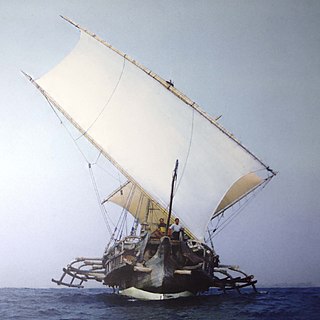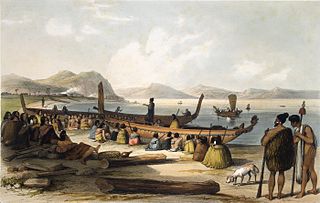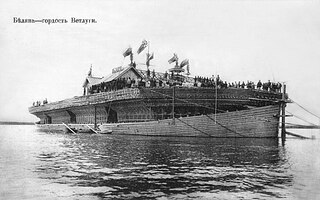
A boat is a watercraft of a large range of types and sizes, but generally smaller than a ship, which is distinguished by its larger size or capacity, its shape, or its ability to carry boats.

Thor Heyerdahl KStJ was a Norwegian adventurer and ethnographer with a background in biology with specialization in zoology, botany and geography.

A raft is any flat structure for support or transportation over water. It is usually of basic design, characterized by the absence of a hull. Rafts are usually kept afloat by using any combination of buoyant materials such as wood, sealed barrels, or inflated air chambers, and are typically not propelled by an engine. Rafts are an ancient mode of transport; naturally-occurring rafts such as entwined vegetation and pieces of wood have been used to traverse water since the dawn of humanity.

A catamaran is a watercraft with two parallel hulls of equal size. The wide distance between a catamaran's hulls imparts stability through resistance to rolling and overturning; no ballast is required. Catamarans typically have less hull volume, smaller displacement, and shallower draft (draught) than monohulls of comparable length. The two hulls combined also often have a smaller hydrodynamic resistance than comparable monohulls, requiring less propulsive power from either sails or motors. The catamaran's wider stance on the water can reduce both heeling and wave-induced motion, as compared with a monohull, and can give reduced wakes.

The Kon-Tiki expedition was a 1947 journey by raft across the Pacific Ocean from South America to the Polynesian islands, led by Norwegian explorer and writer Thor Heyerdahl. The raft was named Kon-Tiki after the Inca god Viracocha, for whom "Kon-Tiki" was said to be an old name. Heyerdal's book on the expedition was entitled The Kon-Tiki Expedition: By Raft Across the South Seas. A 1950 documentary film won the Academy Award for Best Documentary Feature. A 2012 dramatized feature film was nominated for the Academy Award for Best Foreign Language Film.

An inflatable boat is a lightweight boat constructed with its sides and bow made of flexible tubes containing pressurised gas. For smaller boats, the floor and hull are often flexible, while for boats longer than 3 metres (9.8 ft), the floor typically consists of three to five rigid plywood or aluminium sheets fixed between the tubes, but not joined rigidly together. Often the transom is rigid, providing a location and structure for mounting an outboard motor.

Outrigger boats are various watercraft featuring one or more lateral support floats known as outriggers, which are fastened to one or both sides of the main hull. They can range from small dugout canoes to large plank-built vessels. Outrigger boats can also vary in their configuration, from the ancestral double-hull configuration (catamarans), to single-outrigger vessels prevalent in the Pacific Islands and Madagascar, to the double-outrigger vessels (trimarans) prevalent in Island Southeast Asia. They are traditionally fitted with Austronesian sails, like the crab claw sails and tanja sails, but in modern times are often fitted with petrol engines.

Waka are Māori watercraft, usually canoes ranging in size from small, unornamented canoes used for fishing and river travel to large, decorated war canoes up to 40 metres (130 ft) long.

The Uru or Uros are an indigenous people of Bolivia and Peru. They live on a still-growing group of about 120 self-fashioned floating islands in Lake Titicaca near Puno. They form three main groups: the Uru-Chipaya, Uru-Murato, and Uru-Iruito. The Uru-Iruito still inhabit the Bolivian side of Lake Titicaca and the Desaguadero River.

A fish aggregatingdevice (FAD) is a man-made object used to attract pelagic fish such as marlin, tuna and mahi-mahi. They usually consist of buoys or floats tethered to the ocean floor. Various types of FADs have been employed in the traditional fishing cultures of Island Southeast Asia, Japan, and Malta for centuries. Modern FADs are increasingly being used in modern commercial and sport fishing.

The crab claw sail is a fore-and-aft triangular sail with spars along upper and lower edges. The crab claw sail was first developed by the Austronesian peoples by at least 2000 BCE. It is used in many traditional Austronesian cultures in Island Southeast Asia, Micronesia, Island Melanesia, Polynesia, and Madagascar. It is sometimes known as the Oceanic lateen or the Oceanic sprit, even though it is not restricted to Oceania, is neither a lateen sail nor a spritsail, and has an independent older origin.

A disposable ship, also called raft ship, timber ship, or timber drogher is a ship or sea vessel that is intended for use on a single voyage. At the final destination, the vessel is broken up for sale or reuse of materials. Until the end of the 19th century, such ships were common on major rivers such as the Danube and the Rhine in Central Europe and the Mississippi in North America. There were also saltwater vessels that were primarily built for one-time sailing to break up. Some of the largest wooden ships in history were of this type.

Drua, also known as na drua, n'drua, ndrua or waqa tabu, is a double-hull sailing boat that originated in the south-western Pacific islands. Druas do not tack but rather shunt. Both ends of each hull are identical, but the hulls are of different sizes and the smaller one is always sailed to windward. The main differences, compared to proas, are that the hulls have a symmetric U-form profile, and a second hull is used instead of an outrigger. When a float (cama) is used in place of the smaller hull, the craft is called a camakau.
The Fijian double canoe was the largest and finest sea-going vessel ever designed and built by natives of Oceania before contact with Europeans.

Polynesian navigation or Polynesian wayfinding was used for thousands of years to enable long voyages across thousands of kilometres of the open Pacific Ocean. Polynesians made contact with nearly every island within the vast Polynesian Triangle, using outrigger canoes or double-hulled canoes. The double-hulled canoes were two large hulls, equal in length, and lashed side by side. The space between the paralleled canoes allowed for storage of food, hunting materials, and nets when embarking on long voyages. Polynesian navigators used wayfinding techniques such as the navigation by the stars, and observations of birds, ocean swells, and wind patterns, and relied on a large body of knowledge from oral tradition. This island hopping was a solution to the scarcity of useful resources, such as food, wood, water, and available land, on the small islands in the Pacific Ocean. When an island’s required resources for human survival began to run low, the island's inhabitants used their maritime navigation skills and set sail for new islands. However, as an increasing number of islands in the South Pacific became occupied, and citizenship and national borders became of international importance, this was no longer possible. People thus became trapped on islands with the inability to support them.

Totora is a subspecies of the giant bulrush sedge. It is found in South America, notably on Lake Titicaca, the middle coast of Peru and on Easter Island in the Pacific Ocean. The genus Schoenoplectus is closely related to Scirpus and sometimes included therein. This plant can reach a height of 6 m (20 ft) and commonly reaches 4 m (13 ft). The word totora comes from the Quechua language.

The Kon-Tiki Museum is a museum in the Bygdøy peninsula in Oslo, Norway. It houses vessels and maps from the Kon-Tiki expedition, as well as a library with about 8,000 books. It was opened in a provisional building in 1949. In 1957, the current building—designed by architects F. S. Platou and Otto Torgersen—was opened. In 1978, an extension of the museum designed by Torgersen was opened.

Traditionally, many different kinds of boats have been used as fishing boats to catch fish in the sea, or on a lake or river. Even today, many traditional fishing boats are still in use. According to the United Nations Food and Agriculture Organization (FAO), at the end of 2004, the world fishing fleet consisted of about 4 million vessels, of which 2.7 million were undecked (open) boats. While nearly all decked vessels were mechanised, only one-third of the undecked fishing boats were powered, usually with outboard engines. The remaining 1.8 million boats were traditional craft of various types, operated by sail and oars.

Reed boats and rafts, along with dugout canoes and other rafts, are among the oldest known types of boats. Often used as traditional fishing boats, they are still used in a few places around the world, though they have generally been replaced with planked boats. Reed boats can be distinguished from reed rafts, since reed boats are usually waterproofed with some form of tar. As well as boats and rafts, small floating islands have also been constructed from reeds.

Abora is the name of several reed boats built by the German explorer Dominique Görlitz. The expeditions were inspired by previous trans-oceanic expeditions by the Norwegian explorer Thor Heyerdahl. Main aim of the Abora expeditions was to prove that a keel-less reed boat could be steered crosswise and against prevailing winds, using sideboards (leeboards) in lieu of a fixed keel. The name of the vessels was derived from the Canarian deity Abora.

Austronesian vessels are the traditional seafaring vessels of the Austronesian peoples of Taiwan, Maritime Southeast Asia, Micronesia, coastal New Guinea, Island Melanesia, Polynesia, and Madagascar. They also include indigenous ethnic minorities in Vietnam, Cambodia, Myanmar, Thailand, Hainan, the Comoros, and the Torres Strait Islands.



















